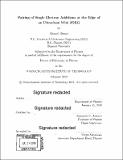Pairing of single electron additions at the edge of an ultraclean Mini 2DEG
Author(s)
Demir, Ahmet,Ph. D.Massachusetts Institute of Technology.
Download1134392166-MIT.pdf (12.96Mb)
Other Contributors
Massachusetts Institute of Technology. Department of Physics.
Advisor
Raymond C. Ashoori.
Terms of use
Metadata
Show full item recordAbstract
In this work, we created laterally large and low disorder quantum well based quantum dots to study single electron additions to two dimensional electron gas systems ( 2DEG). Their single electron addition spectra has been studied using a capacitance technique in a dilution refrigerator. As a function of magnetic field and density, we measured the single electron addition energies from a completely empty dot, up to dot occupancies of thousands of electrons. For small dots, at low density and magnetic field, we found the expected non-interacting Fock-Darwin behavior. However, at high density and high magnetic field, we observed deviations from single particle picture which is suggestive of more novel physics. To observe collective behaviour in quantum dots, we created relatively larger quantum dots so that the dot would behave as a small two dimensional (2D) system. However, observing such behavior has been challenging due to the difficulty in the fabrication of sufficiently high quality devices. The quantum dots we are working on differ from those of previous works in that they do not contain any modulation doping nor a Schottky barrier above the dot. This new design eliminates all unscreened dopants. Instead, we populate carriers electrostatically by an external gate. Here, we report the observation in the addition spectra of interaction driven localized states and isolated tunneling to edge states. We see electron additions to the edge states between filling factors v = 1 and v = 2 with single flux quantum (h/e) periodicity in magnetic field. Remarkably, between filling factors V = 2 and V = 5, we observe the pairing of electron additions to states at the edges of the quantum dots with a corresponding 2e charge tunneling. Near filling factor 5/2 and at fixed gate voltage, these twice-height peaks appear uniformly with a periodicity of h/2e. At other filling factors in the range v = 2 - 5, the mean periodicity for the twice-height electron peaks remains h/2e, but the twice-height peaks are instead further bunched into pairs, with pairs spaced h/e apart. The filling factors for the observed h/2e periodicity coincide with those of a pairing phenomenon seen in conductance oscillations in Fabry-Perot interferometers[1] that indicated inter-channel entanglement between edge channels. Moreover, the unusual 2-electron Coulomb blockade peaks suggest a pair tunneling effect that involves electron correlations that arise in the quantum dot.
Description
Thesis: Ph. D., Massachusetts Institute of Technology, Department of Physics, 2019 Cataloged from PDF version of thesis. Includes bibliographical references (pages 111-115).
Date issued
2019Department
Massachusetts Institute of Technology. Department of PhysicsPublisher
Massachusetts Institute of Technology
Keywords
Physics.